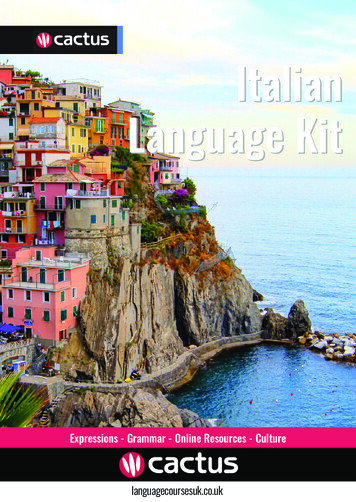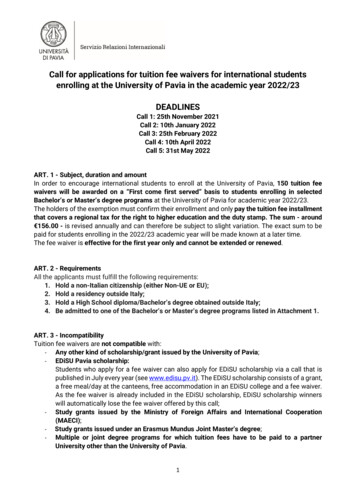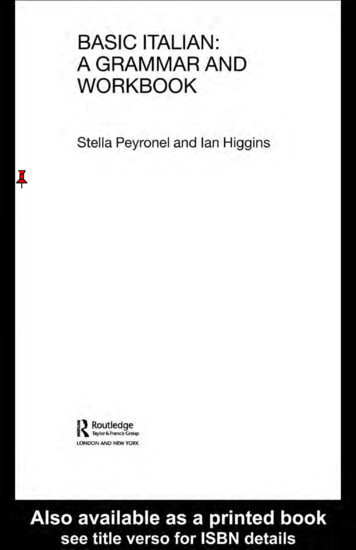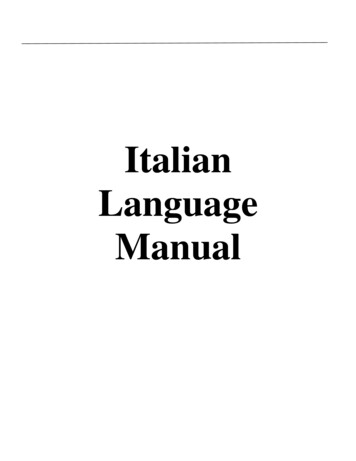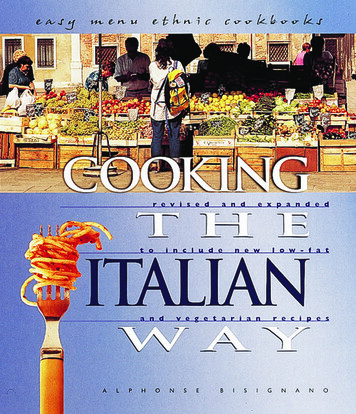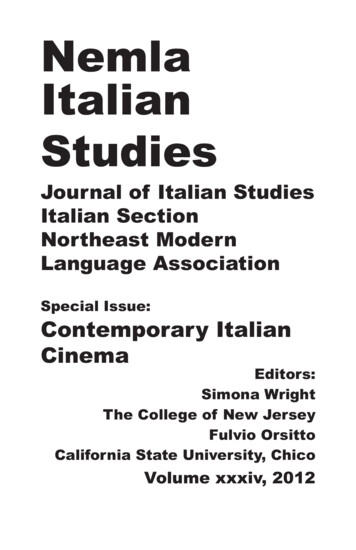
Transcription
NemlaItalianStudiesJournal of Italian StudiesItalian SectionNortheast ModernLanguage AssociationSpecial Issue:Contemporary ItalianCinemaEditors:Simona WrightThe College of New JerseyFulvio OrsittoCalifornia State University, ChicoVolume xxxiv, 2012
ii
Nemla Italian Studies (ISSN 1087-6715)Is a refereed journal published by the Italian section of the NortheastModern Language Association under the sponsorship of NeMLA andThe College of New JerseyDepartment of World Languages and Cultures2000 Pennington RoadEwing, NJ 08628-0718It contains a section of articles submitted by NeMLA members andItalian scholars, exceprts from published and unpublished authors, anda section of book reviews.Participation is open to those who qualify under the general NeMLAregulations and comply with the guidelines established by the editorsof NeMLA Italian Studies.Essays appearing in this journal are listed in the PMLA and Italica.Each issue of the journal is listed in PMLA Directory of Periodicals,Ulrich International Periodicals Directory, Interdok Directory ofPublic Proceedings, I.S.I. Index to Social Sciences and HumanitiesProceedings.Institutional subscription is obtained by placing a standing order withthe editor at the above The College of New Jersey address. Individualsubscription is optained by subscribing online through the NeMLAItalian Studies webpage: www.nemla.org. Each new or back issue isbilled 10 at mailing.*********************iii
iv
Editorial Board for This VolumeFounderJoseph Germano, Buffalo State CollegeEditorsFulvio Orsitto, California State University, ChicoSimona Wright, The College of New JerseyAssistant to the Editors as RefereesPhilip Balma, University of Connecticut, StorrsSimone Castaldi, Hofstra UniversityChiara Ferrari, California State University, ChicoRosetta Giuliani Caponetto, Auburn UniversityVetri Nathan, University of Massachusetts, BostonGloria Pastorino, Fairleigh Dickinson UniversityRenato Ventura, University of DaytonEditorial AssistantAnna Strowe, University of Massachusetts Amherstv
vi
Volume xxxiv2012CONTENTSIntroductionFULVIO ORSITTO AND SIMONA WRIGHT.xiAntonioni’s Photographer: Doubting Thomas or Peeping Tom?Blow-Up as Post-Neorealist Parody.MARY WATT.12001-2011. L’ultimo cinema di Nanni Moretti fra autobiografiae ricerca del padreFABIO BENINCASA.26The Nascent State of Future: Relevance of the MaternalSymbolic and Metonymic in Francesca Comencini’s CinemaANDREA RIGHI.49Archeology of the Future or the Splendor of Moral Realism:The Cinema of Yervant Gianikian and Angela Ricci LucchiLUCA BARATTONI.69Politica cinema e società nel Caimano di MorettiSILVIA CARLOROSI.87Chi ha paura del buio? La favola sonora di Rosso come il cieloTANIA CONVERTINI.109Voyeurism and Desire Keeping The Right DistanceGLORIA PASTORINO.128vii
viii
BOOK REVIEWSFrancesco Ciabattoni. Dante’s Journey to Polyphony. Toronto:University of Toronto Press, 2010.RAFFAELE DE BENEDICTIS.140Pietro Frassica, ed. Shades of Futurism. Futurismo in ombra.Atti del convegno Internazionale. Princeton 9-10 ottobre 2009.Novara: Interlinea, 2011.ROBERTO NICOSIA.143Rosa Giulio. Gli infiniti disordini delle cose. Sullo Zibaldone diLeopardi. Salerno: Edisud, 2012.MARK EPSTEIN.146William Hope. Giuseppe Tornatore. Emotion, Cognition,Cinema. Newcastle upon Tyne (UK): Cambridge ScholarsPublishing, 2008.FULVIO ORSITTO.148Roberta Ricci. Scrittura, riscrittura, autoesegesi: voci autorialiintorno all’epica in volgare. Boccaccio, Tasso. Pisa: EdizioniETS, 2010.MARTINA DI FLORIO GULA.151Frank Rosengarten. Giacomo Leopardi’s Search for a CommonLife through Poetry: a Different Nobility, a Different Love.Madison (NJ): Fairleigh Dickinson University Press, 2012.MARK EPSTEIN.154Grace Russo Bullaro. Beyond Life is Beautiful. Comedy andTragedy in the Cinema of Roberto Benigni. Leicester (UK):Troubador Publishing Press, 2005.FULVIO ORSITTO.157ix
Giulia Santi. Sul materialismo leopardiano. Tra pensieropoetante e poetare pensante. Milano: Mimesis, 2011.MARK EPSTEIN.160Edoardo Tabasso and Marco Bracci. Da Modugno a X Factor:Musica e società italiana dal dopoguerra a oggi. Roma:Carocci, 2010.SABRINA OVAN.164x
IntroductionThis monograph volume of the NeMLA journal of ItalianStudies proposes a series of reflections on Contemporary ItalianCinema. In the past couple of decades, Italian directors have beenmore than ever shooting in the present tense (to use Millicent Marcus’expression), making films that were recording the complexities ofa changing socio-political and cultural context and were markedby an ever-growing activity of investigation, problematization, andnegotiation of national identity. Such a process was facilitated by newintersections between different cultures and, in general, by the greatergeographical and cultural porosity of the traditionally conceivednational borders. Providing audiences with a unique perspectiveon many social, political, and economic changes, contemporaryItalian cinema reflects how Italians began to face their own ‘colonialunconscious’ with respect to their external Other (represented bythe so-called ‘extracomunitari’) and the internal one (the South).Moreover, some of the so-called ‘new Italians’ have recently acquireda filmic authorial voice that elaborates a refreshingly multilayeredview on and of Italians, challenging their ‘Italianness,’ and offeringglimpses of future possible acculturations by proposing complex butfruitful interactions.In addition, in the past couple of decades Italian cinema hasalso been confronting its own past, struggling on one side to renew filmgenres and redefine their boundaries, while on the other focusing onthe cumbersome inheritance of Italian Neorealism. Clearly, besides thecalligraphic penchant of several films of the early 1990’s, which wereoften labeled as neo-neorealist, one may notice a constant presenceof the Neorealist ghost resurfacing in the works of many directors,a manifestation that a more in-depth investigation will unmask as arather superficial ‘mood,’ a generic social ‘impegno’ that has nothingto do with a thoughtful renegotiation of the old masters’ legacy.In order to better locate, historically and contextually, thedevelopment of new authorial perspectives, this volume begins withan essay by Mary Watt on Michelangelo Antonioni. One of the firstItalian auteurs trying to exceed the Neorealist boundaries and to reflectupon the nature of reality and the quest for truth, Antonioni creates, inxi
INTRODUCTIONWatt’s words, “a meta-parody in which his use of hagiographical andpopular traditions is itself a parody of the Neorealist tradition” (q.v.1) Watt explores Antonioni’s intention as articulated in one of hismost intriguing oeuvres, Blow Up, where most clearly one detects the“filmmaker’s break with Neorealism’s belief that truth was knowableand reality capable of filmic representation, even if not always at theliteral level of the narrative.” (q.v. 1)The following group of essays is devoted to the examinationof some of the most noteworthy contemporary Italian auteurs. FabioBenincasa explores the autobiographical echoes that distinguish thecinematography of Nanni Moretti, arguably the most influential andcelebrated of contemporary Italian directors. Benincasa’s analysis ofMoretti’s stylemes offers in-depth reflections upon Michele Apicella’scharacter, but also upon the recurring presence of father figures,metacinematic aspects and the frequent psychoanalytical references.Andrea Righi investigates Francesca Comencini’s cinema, showingits complexity both in terms of theoretical contents and modalities ofexpression, and highlighting the presence of symbolic and metonymicaspects. Moreover, Righi stresses how in Comencini’s cinema issuesof gender and politics are always strictly interconnected, and howthe private sphere is often the site for larger political conflicts. LucaBarattoni underlines how the persistent resurfacing of realism in ItalianCinema affects independent directors such as Yervant Gianikian andAngela Ricci Lucchi, urging them to find their own way to cinémavérité, a new “moral realism” that elicits an ethical response on theviewer’s part. The second group of essays proposes the analysis ofthree very different filmic experiences. Silvia Carlorosi emphasizesthe elaboration of a discourse that conflates politics and society inNanni Moretti’s Il caimano (2006). In the film, Carlorosi identifiesa narrative that entwines both levels, private and collective, in adynamic exchange of crisis and resolution. Tania Convertini analyzesthe experience of blindness exemplified in Rosso come il cielo (2006),by independent filmmaker Cristiano Bortone. A challenging andmildly provocative work that lays bare, after Convertini’s analysis,the suggestive message the director has imbedded in its narrative:being blind does not represent an absence but rather a condition ofpotentiality, where existence can be lived in its fullness. Lastly, in herxii
INTRODUCTIONinvestigation of Carlo Mazzacurati’s La giusta distanza (2007), GloriaPastorino focuses on journalism and media as producers of voyeurismin a society more and more founded on surveillance and spectacle.At their intersection, these elements conflate, on the individual andcollective level, with the Lacanian “lost object” of desire, occasioningunintended and often ruinous consequences.With NeMLA Italian Studies, Volume XXXIV, Special Issueon Contemporary Italian Cinema, the editors intended to offer anopen forum to Italianists and cinema scholars for new and stimulatingpaths of intellectual exploration while at the same time allowing thediscourse of Italian contemporary cinema to thrive and deepen. Wehope to have achieved both objectives.Fulvio Orsitto and Simona Wrightxiii
xiv
Antonioni’s Photographer: Doubting Thomas or Peeping Tom?Blow-Up as Post-Neorealist ParodyIt has been more than forty years since the release ofMichelangelo Antonioni’s 1966 classic Blow-Up engendered amassive amount of intellectual and artistic attention. The scholarshipon the film is extensive and it seems that no survey of Italian filmwould be complete without at very least a few paragraphs devotedto the question of what Blow-Up was trying to do or say. While thereis some agreement that the film probably addresses the relationshipbetween the artist and his creation and or the nature of reality and thequest for truth, there was very little criticism devoted to the questionof what precisely, in terms of genre, Antonioni had created.1 Lookingback at several decades of criticism with fresh eyes, it seems thatperhaps the reviewers (even those who had alerted us to the possibilitythat the film was a metaphor,) like Antonioni’s photographer, havemissed something that was right before their eyes; that is, that the filmis ultimately an intricate exercise in multi-level parody.2 In this articlethen I will examine how Antonioni crafts such parody and argue thatBlow-up relies on two complementary traditions, the Gospel storyof Doubting Thomas and the folkloric figure of Peeping Tom, tounderline modernity’s break with the past and the crisis of faith it hasengendered. Concomitantly, I propose that Antonioni uses the figureof the photographer not to mock the dilemmas figured by a skepticalapostle and a repressed voyeur, but rather to point out the inability ofthe modern photographer or filmmaker to deal genuinely or adequatelywith either dilemma. In this latter aspect, I suggest that Antonionihas also created a meta-parody in which his use of hagiographicaland popular traditions is itself a parody of the Neorealist traditionintended to further emphasize the modern filmmaker’s break withNeorealism’s belief that truth was knowable and reality capable offilmic representation, even if not always at the literal level of thenarrative.Blow-Up’s synopsis is well known and need not be repeatedhere.3 Two scenes in particular, however, bear mentioning and providea good starting point from which to explore how Antonioni goes aboutcrafting his multi-layered parody. Let us consider first then the scene1
Wattin which Thomas returns to the park without his camera to see if thereis indeed a body hidden in the bushes. In a moment that is highlysuggestive of a possible affinity between Antonioni’s photographerand the doubting disciple, Thomas reaches out to touch the body, toconfirm what he sees. When he returns the next day with his camera,however, the body is gone, raising the question of whether in fact itwas ever really there. Thomas’ doubt was not assuaged by his touching;rather, his trust in his own senses has, seemingly, been dealt a seriousblow. Moreover, it is not the first such blow nor will it be the last.Throughout the film, as Thomas wonders about the reality of whathe has seen or photographed or imagined, the tenuous nature of whatconstitutes reality is continually undermined by a series of seeminglyrandom encounters; two of which seem particularly pertinent to hisown conundrum. The first is a brief conversation with Verushka, themodel he was photographing earlier in the film. Her deadpan assertionthat she is in Paris (although Thomas is quite certain they are bothat a London party) suggests solipsistically that each of the film’scharacters creates his or her own reality. The second, an encounterwith a group of mummers that closes the film, reiterates the samepossibility and encapsulates the dilemma that hounds Thomas. Themummers playing tennis with an imaginary ball urge Thomas to pickup that which he cannot see when the “ball” is hit out of bounds and“lands” at his feet. We the viewers are tempted to assume that there isno ball and that Thomas is just playing, pretending to see. At the sametime, however, we also wonder if Thomas has abandoned his physicalsenses as purveyors of truth, given how unreliable they seem to havebecome. As Thomas stoops to retrieve and throw the imaginary ball, acrane shot pulls away from him and he disappears from our view. If,as James S. Williams has suggested, all of Antonioni’s works may beregarded as essays on the relations between reality and its perception,(52) here then we see the crux of the debate. Now invisible, Thomashas become to the audience what the man in the thicket was to Thomas,as we ask ourselves, was he ever really there? Is Thomas any less realnow that we cannot see him than when he was but light flickering ona movie screen? The viewer’s doubt echoes the photographer’s doubtand the clever viewer will be reminded of the disciple who could notbelieve in a risen Christ unless he had himself put his fingers in his2
ANTONIONI’S PHOTOGRAPHERteacher’s wounds. The typological affinity between the two doubtingThomases thus creates the basis of a parodic construct through whichAntonioni challenges the viewer’s faith in the truth of the creator’sfilmic construct. At the same time, Antonioni uses this affinity toremind us of another tradition, the Neorealist tradition from which heand modernity have become estranged.Indeed it is Blow-Up’s use of characters typologicallyconnected to hagiographical and popular traditions to create apolysemous narrative that forges the most obvious link to theclassics of Italian Neorealism and thus to Antonioni’s earliest artisticformation.4 In Rome Open City (1945) Roberto Rossellini, for example,relied on name play and iconography, devices common to medievalhagiographical narratives, to create an allegorical level of meaning inhis documentary-style drama about partisans in Rome during the Nazioccupation. The characters’ names, in particular, Giovanni Episcopoand Pietro Pellegrini, together with a scene in which the capturedpartisans are taken towards the Palazzo della Civiltà, Mussolini’snew coliseum, created a typological affinity between the partisansand Christian martyrs being persecuted by a pagan empire. Thistypological affinity5 thus elucidated the “true” meaning of the struggleagainst Fascism. That the partigiani are to be regarded as the lambsof God is underlined when Nazi officers shoot two sheep inside arestaurant. Although the moment does not advance the literal narrativeit serves, as do many of the hagiographical allusions, as an interpretivekey, alerting the viewer to an underlying layer of significance at oddswith the alleged objectivity of the Neorealist camera.Similarly, the hapless Antonio of Vittorio De Sica’s Ladri diBiciclette (1948) recalls the saint renowned for finding lost things and,combined with De Sica’s branding the lost bicycle “fides,” transformsan ostensibly political film into a parable not only about the search forthe means of making a living, but also about the quest to recover one’slost faith. The film’s polysemy asserts that Antonio is a failure onlyin the nominally “real world,” that is, the literal narrative of the film.When, in the final moments of the film, his son Bruno grabs Antonio’shand, the audience is certain that what was lost has been found andthat Antonio’s search has been successful even if he has not recoveredhis bicycle. Further, the closing shot underlines the affinities between3
WattBruno and Christ that De Sica has been hinting at throughout the film:Bruno the Christ figure has equally recovered his lost lamb. (Theobservant viewer will recall that De Sica alluded to Antonio as a lostlamb in a seemingly random yet obviously significant panning shot ofa poster advertising “lana (wool) di Sant’Antonio.” Just as a movieposter of Rita Hayworth first alerted the viewer to the inherent artificeof the literal layer of De Sica’s project, so too does another posterdirect us to the existence of another layer of significance.)Thus even in its earnest effort to present reality, ItalianNeorealism could not restrict itself to the bare literal. Moreover, itsdirty little secret was that the reality it purported to present was, inmany cases, the product of artifice. In The Bicycle Thief, as in RomeOpen City, the effect of watching real life was the result of De Sica’sintentional manipulation of the mise-en-scène and highly orchestratedcamera work. Masterful in its artifice, De Sica’s film is brilliantprecisely because it hides its artifice so well. To adapt a famous bitof Dante criticism;6 the greatest fiction of The Bicycle Thief is that itis not fiction. The verisimilitude of film is such, however, that it canmake anything look real even when it is the result of artful fabricationand manipulation. Real truth, on the other hand, the Neorealists tellus, is locatable within the deeper allegorical level to which the literalcontinually if only subtly, alerts us.7Federico Fellini, who collaborated with Rossellini on RomeOpen City, not surprisingly spent much of his career exploring thetension between these two layers. Exploiting the filmmaker’s abilityto photograph the seemingly real, Fellini’s films continually exposethe artifice inherent even in the so-called documentary and encouragethe viewer to doubt the “truth” of the literal level. Fellini broaches theissue in The White Sheik (1952) (which was developed from a storywritten by Antonioni) but it is in La Dolce Vita (1960) where Felliniconfronts directly what John Freccero has called the “extraordinarymeans the medium provides in order to lie” 8 (120). In La DolceVita, when Fellini films photographers photographing the movie starSilvia’s arrival in Rome, he also films them re-filming her arrivalso as to produce a more dramatic shot of the moment. The vieweris thus sensitized to the tension between the original and a copy orbetween truth and its representation. The question then is whether it is4
ANTONIONI’S PHOTOGRAPHERreasonable to believe anything this manipulator presents as literal truth.Perhaps just as significantly, however, Fellini’s act of photographingthe act of photographing, at the same time also raises the issue of thefilmmaker’s meta-filmic role in creating this artifice.As in Rome Open City and The Bicycle Thief, in La DolceVita, a putative resolution emerges from a series of veiled biblical andhagiographical references and the names of several key characters thatalert us not only to the artifice of what we are watching but also tothe truth contained within the lie. Like a carnival mask then, this lie,this artifice both conceals and reveals and La Dolce Vita is graduallyunderstood as a literal narrative that purports to be true but whichalso contains a truer allegorical meaning. The closing shot of Marcellofading into the background tells us that the literal is but artifice and thatthe allegorical level is where one finds the truth. Marcello, however,while cognizant of the constructed nature of the world of the publicistand paparazzi, cannot or will not see the veiled meaning that lieswithin. Accordingly, the fish that he and his fellow revelers find on thebeach, dead for three days, will not be resurrected. In contrast to DeSica’s symbol of faith, the bicycle named fides, Fellini’s fish loses itssemiotic potential and is reified, for the protagonist fails to see whatlies beyond, hiding himself behind dark glasses.9 Such is the situationof Antonioni’s photographer who, like St. Paul, at first sees the literalbut does not see in full and then later sees but like St. Thomas, doubts.In this way Blow-Up not only gives nod to Antonioni’s own artisticformation but also to the hermeneutics underlying much of the ItalianNeorealist project.Given the number of affinities that critics have observedbetween Blow-Up10 and Fellini’s works it seems legitimate toresituate it within that same allegorical tradition that informs not onlyFellini’s films but also those of De Sica and Rossellini. The mostobvious link to the tradition is signaled by the name play Antonioniemploys in identifying the photographer as Thomas.11 Although thephotographer’s name is not used in the film, the screenplay is clearthat the photographer is named Thomas. Moreover, Antonioni refersto the character as Thomas in interviews both during the filming ofBlow-Up and afterwards. But even if the character were not so named,his obvious connection to the disciple who would not believe in the5
Wattresurrection until he had put his finger in the wound is emphasizedin the scene in which the photographer returns to the park withouthis camera to touch the body. The photographer’s doubt is reinforcedwhen he returns – in typical Fellini style – at daybreak, with his camerafor “proof” of the body, only to find that it is not there.There are other subtle indications in the photographer’sbody language that equally suggest he might be linked to the figureof Doubting Thomas. During the encounter with Jane in his studio /apartment, when Thomas offers her a cigarette, his arm is positionedin a manner exceptionally evocative of Andrea del Verrocchio’s St.Thomas in Florence’s Orsanmichele.12 It is of course, highly likely thatAntonioni had seen this sculpture but even if he had not, Verrocchio’sdepiction of the moment in which Thomas extends his hand to feelthe wound of Christ, is certainly not original in its iconography13and Antonioni may have had any number of representations ofThomas in mind as he moved his characters around the set. Thepossibility of Antonioni’s absorption of the image to lend meaningto his photographer is intriguing. One can only wish that someonehad asked Antonioni about the photographer’s name during the manyinterviews concerning the film, for it is difficult to imagine it is merecoincidence especially given the hagiographical tradition that attendsthe figure of Thomas. In the Golden Legend, for example, Jacobus deVoragine describes Thomas as an architect who was “very skillful inthe art.” Laurie Taylor-Mitchell expands on this and suggests that itwas Thomas’ role as an artist, “involved with manipulating tangiblematerials” that so aptly connected the figure of Thomas to his demandfor physical evidence of the resurrection. (608)There is a further semiological aspect of the Thomas legendthat is equally suggestive of a link between Antonioni’s photographerand the Gospel tradition. The Apostle’s act of probing the wounds ofChrist, of physically inserting his body (or part thereof) into that ofanother, is ripe with almost unfathomable symbolism. For the purposeof this essay, though, it is enough to recall that Thomas, Antonioni’sphotographer not only seeks to touch the body he finds in the bushes,but is also constantly engaged in the act of gazing upon it (by meansof his blow-ups) and others, an act that Roland Barthes has associatedwith punctum, or probing. Indeed Thomas’ gazing is accentuated and6
ANTONIONI’S PHOTOGRAPHERexaggerated in the early scenes of the film where Thomas is “probing”the model Verushka with his enormous camera. It bears noting aswell that the image of the supine emaciated Verushka,14 with her armsoutstretched, cannot but help remind the viewer of a crucified figure.15Significantly, the vast majority of criticism ignores theassociation of Thomas the photographer with doubting Thomas.In a 1967 review of the film, Carey Harrison makes only a passingreference to the name play, stating with regard to the ending of thefilm: “the Thomas once so sure he could interpret what was real,confesses himself a doubting Thomas, a humble ignorant Thomas”(41). Jean Clair’s article “The Road to Damascus” allows for anallegorical interpretation, but in his allusion to the conversion ofPaul16 he fails to note the more obvious connection to Thomas theApostle. One expects that the failure to make the connection lies withthe critical formation of the critics commenting on Antonioni.17 Whilethey often recognize the need or potential for a deeper more allegoricalmeaning, there is little recourse to the methodology commonly usedby scholars of medieval art and literature. In contrast, John Freccero,a renowned Dantist, renders a more satisfying interpretation of BlowUp, as he connects the hermeneutics of Antonioni’s project to themedieval literary tradition that preceded him.18 Specifically, Freccero’srecognition of the metaphoric relationship between the film’s directorand the protagonist invites us to see Antonioni’s project as akin tothat of the Divine Comedy,19 in which the protagonist is a metaphorfor the author, and the allegorical meaning of the protagonist/author’sexperience, as depicted in the literal narrative, is explicated throughthe use of typology.Freccero’s recognition of Blow-Up’s consistent inclusion ofmedieval and Renaissance artistic traditions,20 also urges us to adoptsuch a methodology as a means of deciphering the film’s allegoricalsense. Identifying a number of imbedded images21 Freccero allowsthe viewer to see others, and to see the affinities between Antonioni’scharacters and the types they represent. Antonioni thus, like themummers, compels us to see something we did not at first see, a questthat is encouraged by Thomas’ friend the painter who suggests thatthere may be parts in his work that are not immediately recognizablebut which will emerge at some point. What Antonioni is doing then7
Wattseems akin to what his predecessors were doing with Antonio Ricciand Pietro Pellegrini.22 While the vast majority of film critics andscholars may not have immediately seen Doubting Thomas, Freccero’sapproach to Antonioni’s hermeneutics justifies us finding him.At the same time, this signifying strategy serves not only toilluminate the allegorical level of meaning but also to link Blow Up toits Neorealist antecedents as the character of Thomas serves as morethan a mere nod to Antonioni’s Neorealist past. A closer look at thecharacter suggests that Antonioni, in addition to using typology toexplicate the allegorical significance of Thomas has also relied on itto create a parodic relationship between the modern photographer andthe gospel figure which in turn, desacralizes the Neorealist project andits attempts at truth-telling.Antonioni’s Thomas in his dual-layered significance functionsthen as a parody not only of the biblical Thomas, as a cynicalpostmodern version of a gospel story emphasizing the emptinessof and the impossibility for truth in a world that is moderated andmediated through technology, but also of an entire genre. Had ourphotographer been a simple evocation of Thomas he would have beensatisfied with touching the body and we would have been remindedhow much more blessed he would have been had he believed withoutseeing. Instead, the photographer’s doubt is amplified and the supermodern Thomas’ belief that he might know through his camera ismocked. In that moment so too is the viewer’s faith in verisimilitudeand indeed, in the recorded image, ridiculed.23If Blow-Up is in fact a parody, it would not be the first timethat the Thomas figure has been used parodically to address the issueof trust. Roy Peter Clark has argued
Simone Castaldi, Hofstra University Chiara Ferrari, California State University, Chico Rosetta Giuliani Caponetto, Auburn University Vetri Nathan, University of Massachusetts, Boston Gloria Pastorino, Fairleigh Dickinson University Renato Ventura, University of Dayton Editorial Assistant Anna Strowe, University of Massachusetts Amherst
